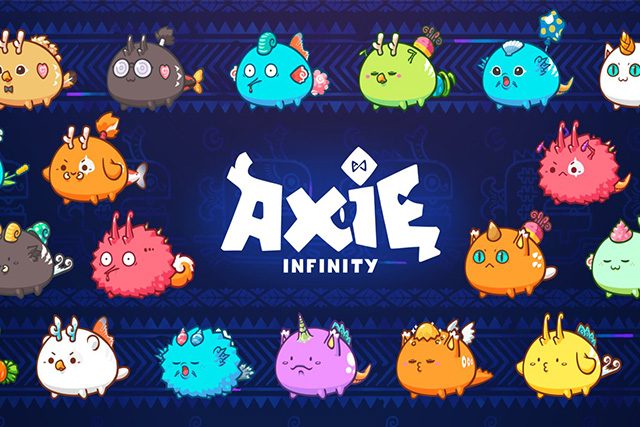The ultimate point of playing video games has always been to have fun. Whether it’s Space Invaders or Sonic or Red Dead Redemption, you hit the start button and do your thing until game over – and then you probably wipe the sweat off your hands and do it again.
But a new class of games is emerging where playing is an investment opportunity – and even potentially a way to earn a living. So-called play-to-earn games like Axie Infinity and The Sandbox have been exploding in popularity recently.
What they have in common with many previous classics is that they include complex economic ecosystems. In the 1980s blockbuster Elite, for example, players travelled from planet to planet, trying to increase their credits by buying and selling things like weapons and commodities. Or in life-simulation franchise The Sims, players buy everything from pizzas to houses with Simoleons.
But in these older games, the in-game currency had no value in the real world. There have also been games like World of Warcraft where a grey market for exchanging in-game items and characters grew up around them. But play-to-earn games take this to a whole new level. So how do these games work and where are they heading?
To infinity …
The leader in this new space is Axie Infinity, a Pokémon-style game created by the Vietnamese developer Sky Mavis. It has some 350,000 daily active users, about 40% of whom are in the Philippines, with Venezuela and the US the next two biggest markets.
The game revolves around cute furry creatures called Axies, which players breed, acquire, train, use to complete challenges, and do battle with online. The object of the game is to obtain small love potions (SLPs), which can be used to breed new Axies that can then be deployed within the game.
SLPs double as cryptocurrencies that can be bought and sold on a crypto exchange. Top players are reportedly earning SLP1,500 (US$435/£317) per day from their Axies, though the price of SLPs against the US dollar is constantly changing. It has broadly been rising since 2020, so there is an argument for hanging on to them – or alternatively, selling while the going is good.
Axies themselves can be traded in real life in the likes of the Axie Marketplace as NFTs (non-fungible tokens). NFTs are digital collectables that exist on online ledgers known as blockchains, and are better known for recently taking the art world by storm.
As well as Axies, other in-game items like real estate, flowers, barrels and lamps are all tradeable as NFTs too. These are all bought and sold using ethereum, which is the second biggest cryptocurrency after bitcoin.
This is a welcome improvement on predecessors such as World of Warcraft where trading of gold and in-game assets took place in unaffiliated auction sites, and was grounds for being banned from the game for a long time. By introducing a dedicated marketplace, NFTs and a blockchain, the trading around Axie Infinity and similar games is more secure and means that players actually own the items in question.
To get started on Axie Infinity, players need to buy (or borrow) three Axies. They are available from US$190 (£138), though the
current average is about US$350, and higher level, rare or mystic Axies can sell for a lot more.
The most expensive ever Axie, a triple mystic called Angel, sold for ETH300 in late 2020, which was around US$120,000 at the time. Meanwhile, a chunk of in-game real estate went for US$1.5 million earlier in 2021. Monthly trading volumes for all Axie Infinity NFTs currently stand at US$170 million.
Finally, there is another cryptocurrency associated with this game called the Axie Infinity shard (AXS). Investors in AXS have a vote in the governance of the game’s ecosystem, and can also use it to get a share of the community treasury. AXS has also seen an impressive rise recently, up about sixfold in recent weeks. It is the largest gaming cryptocurrency on the market.
…And beyond
Besides Axie Infinity, CryptoKitties is another play-to-earn game that has built up a substantial following. In that game, players buy, breed and trade digital cats using ethereum. Again, these cats are NFTs, which generate wealth not just for the developers but also the player community. The most expensive CryptoKitty sold to date, which was called Dragon, went for ETH600 (around US$170,000 at the time).
Apart from generating real income for players, play-to-earn games also create communities where gamers and creators can meet, share wisdom, and do deals with one another. A good example of this is The Sandbox, a game in the same genre as Minecraft where players build things and exchange with them with one another as NFTs.
This discreet economy is driven by its own cryptocurrency, SAND. One way to make SAND is to sell parcels of digital real estate known as LAND, which players can purchase for their shopfront as a way of sharing experiences with visitors to the world. In February alone, the game announced that a record 2,352 plots of LAND had been sold for a combined US$2.8 million.
With such levels of interest, major brands are seeing the potential to take a piece of this expanding metaverse. For example, The Walking Dead will soon be opening its doors on the platform, allowing players to enter a zombie world within the game, in what Sandbox says is a step towards a “virtual attraction park”. Brands like these are presumably likely to draw a more mainstream audience to the platform.
Now that games like these are possible, it seems likely that they are here to stay. Many games have sustained online communities in the past, but by adding the ability to make financial gains, play-to-earn games will potentially lead to even more successful communities in future. If this corner of gaming is new to you, it’s time to start watching closely.![]()
Drew Cattanach, Lecturer in Computer Games Development, University of Westminster. This article is republished from The Conversation under a Creative Commons license. Read the original article.







